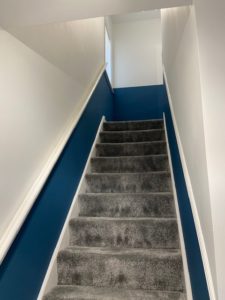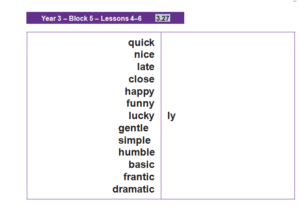Hello everyone! We hope you are well… What have you been up to this week? You can let us know by using the email addresses:
lionclass@stpeterswaterlooville.hants.sch.uk and hippoclass@stpeterswaterlooville.hants.sch.uk
This week, Mrs Pike has been very busy on the farm. Together with her daughter, she’s been making sure that she captures every exciting aspect and incredible moment on film and has been working hard to edit all the clips together to make a video tour just for you! Make sure you watch their amazing footage here…
https://www.youtube.com/watch?v=5dtJEoNiC2A
Mrs Atkins has attempted hairdressing this week. After using the clippers upside-down on Mr Atkins’s hair, cutting a wonky fringe for her daughter and lop-sided ears for Ziggy the dog, she has decided that she should probably stick to teaching!
Miss Shaw has been busy painting her hallway- what do you think?


Home learning for Friday 24th April
Topic :
Food has to be farmed, caught or grown at home.
Questions for the children to record their answers – can be presented anyway they wish – be creative.
• Have you ever visited a farm where animals live?
• What did you see?
• What animals live on farms?
• What do you think an animal needs to grow and stay healthy?
Virtual farm tour – we were going to go on a school trip this term to Mr and Mrs Pike’s farm on Hayling Island. As we can’t do this, Mrs Pike and her daughter, Imogen filmed this amazing video for us!
https://www.youtube.com/watch?v=5dtJEoNiC2A
English:
Design a leaflet advertising the farm – try to remember our persuasive techniques to encourage people to go there. These include: amazing adjectives, rhetorical questions, key facts and special offers. This link has some nice ideas about what you might like to include… http://www.virtualfarmwalk.org/assets/pdf/getbusy-marketing.pdf
Guided reading
http://www.virtualfarmwalk.org/assets/pdf/how-precious-is-soil.pdf
Together with your child, read through the above text and if possible do the activity, noting that fruit and a knife are required! For those of you who have struggled with the guided reading over the past weeks, talking it through together and doing a practical activity like this should help vital information resonate with your children and mean that they can recall and retain it more easily.
Now skim and scan to find the answers to these questions in the text:
1. What fraction of our world is land?
2. Why is half of this land not suitable for farming?
3. Of what is left, how much can be farmed and why?
Remember you can present your guided reading however you wish – see if you can make it fun.
In addition, you can use this same text to complete your Geography.
Geography:
Can you use a globe, world map (from an Atlas or online) to be an explorer? Can you discover the names of as man seas and Oceans as possible? Now name the continents? Where do you live? What Town, City, Country, Continent? Can you find it on a map?
Science:
To know that people can grow their own food at home.
Talk to your child about what can be grown at home:
• Do you grow any food at home?
• Does anyone you know?
• What sorts of things can be grown at home?
• Where about are things at home grown? (Allotment, greenhouse, garden, window sill.) Can you find 3 different places where you think would be a good place to grow food where you live? Draw a picture / take a photograph of these places and label it telling us why they’d be good
• Can you use this time to grow some food of your own? I know some of you have started this already and we can’t wait to hear all about it when we call you.
Science from Miss Stapley
STATIC MAGIC
The activity: Make objects move without touching them by charging them with static electricity. ExpeRiment: with different objects to see how static electricity affects them. Learn about charged particles like electrons and how things gain or lose charge.
https://www.rigb.org/families/experimental/static-magic – for a video clip about the experiment and a full version of the activity information sheet.
What you will need:
• A balloon • A cotton towel or T-shirt or a woolly jumper • Some scrap paper • A paper/plastic drinking straw (optional) • An empty 500ml plastic drinks bottle (optional) • A hard plastic comb or ruler (optional) • Other household objects to test.
What to do:
• Charge up a balloon and try picking up scraps of paper with it.
• Investigate whether the amount you rub the balloon affects how much paper it can pick up.
• Investigate whether the size of the scraps of paper makes a difference.
• Find out how close you have to be to the paper before the balloon makes it move.
• Try bending a stream of water like Hector does in the video.
• Try balancing a straw on top of a bottle lid and seeing if you can make it spin like in the video.
• Find out which objects are attracted to the charged up balloon and which are repelled by it.
• Try holding a charged balloon near your hair or your skin.
Going Further:
Try rolling an empty soft drink can along the ground using a charged up balloon http://bit.ly/StaticCanRoll
Try lighting up a fluorescent lightbulb with a charged up balloon – as described here: http://bit.ly/LightBulbBalloon
Try tying two balloons to strings and seeing if you can charge them up with static electricity then hang them up so they repel each other.
Read more about static electricity http://bit.ly/MoreStaticScience
HAVE FUN!
Maths
Below is a link to a maths activity focusing on arrays. Remember arrays need to be neat and in lines to help count accurately.
https://maths.hias.hants.gov.uk/pluginfile.php/5413/mod_resource/content/2/Year%203%20Home%20Resources%20Problem%202.pdf
Below is a pack of pea themed array activities- see which one works best for you!
T2-M-1694-Year-3-Differentiated-Pea-Pod-Arrays-Activity-Sheets
Remember My maths, sum dog and times tables rock stars is updated each week too.
Spelling
Look at the below matrix. Practice saying the root words on the left and then try to say them with the addition of the suffix –ly. Most of the new words sound like normal (with the exception of the words ending in –le) but they may be spelt incorrectly if you don’t adapt them.

Using a dictionary (and a grown up – this is a toughie!) come up with rules or conventions for how to accurately add the suffix -ly to words with different endings. One has been done for you as an example:
Ending in ‘y’
Ending in ‘le’ Change the ‘le’ to ‘ly’.
Ending in ‘ic’
Practice these words – and any others you can apply the rules to – using your favourite strategies. As a challenge, can you find any 1 syllable words ending in ‘y’ that do not follow the rule when the suffix ‘-ly’ is added? Can you find the one exception (that we know of) that ends in ‘ic’ but doesn’t follow the rule?
Art from Mrs Pearson : UNDER THE SEA challenge
The title for your art this week is ‘Under the Sea’. This can take the form of a drawing, a painting, a sculpture, a collage or anything else that you would like to create. As always, I’m sure you will impress me with your creativity!
Here are some ideas

However, if this doesn’t appeal to you can still send any other art work to me and I will post that on the Blog too.
Please email your artwork to me:
n.pearson@stpeterswaterlooville.hants.sch.uk
Thank you
Keep creating and keep safe!
Mrs Pearson
Music from Mrs Sumba
Steve Reich and Music for 18 Musicians
Go to the website below and watch Naomi Wilkinson’s video about Steve Reich. Try to answer her questions and join in with the activities she sets.
https://www.bbc.co.uk/teach/ten-pieces/classical-music-steve-reich-music-for-18-musicians/zk44y9q
Have a wonderful week, stay safe.
Miss Shaw, Mrs Atkins and Mrs Pike
Mason really enjoyed watching the tour of the farm and said he would love to help and work with animals one day and hopefully gets to visit the farm .
Mrs white